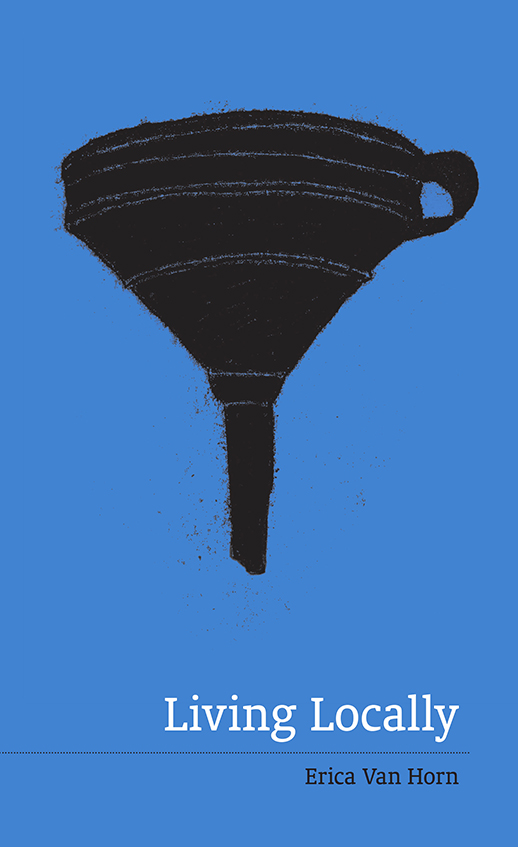Erica Van Horn; Living Locally
Uniformbooks. Foreword by Susan Howe
66 black and white drawings. 144pp, 234 x 142mm, sewn paperback with flaps.
A review by Neil Sentance.
‘27 June 2007 – Tom Browne told me about the dances when he was young … the girls were always on the lookout for men with wrinkles in the back of their jackets. The wrinkles meant that a man had arrived by motor car. Those men who had arrived without wrinkles travelled on foot or by bicycle, and so they were considered second best.’
So begins Erica Van Horn’s diary record of living in deep rural Ireland. The charm of this opening is sustained over seven years, a charting of the variety of everyday life among the rainy farmlands of southern Tipperary. The writer has lived here with her partner Simon Cutts, writing and making art, for the best part of two decades, and has produced this engaging chronicle of place. She describes the slowly changing community of farmers and fellow blow-ins over the peak Celtic Tiger years and its subsequent messy collapse into economic hardship. In entries of a few lines each we slowly become acquainted with landworking neighbours; the village dogs, ill-tempered llamas and gloomy donkeys; the minor roads and sodden fields; and the fading generation of the old. The patterns of life in this corner of the island are plainly arrayed before us, but what nourishment it is. The old ways persist in the face of creeping modernity. The frequent power cuts cast scenes in candlelight and shadow. Walking and talking become Olympian pursuits. The simple pleasures of a stroll to the shops, or with the dog, watching the floodwaters surge down the boreen after a winter storm, growing your own vegetables or chatting with a neighbour seem to become a manifesto for a life well lived.
The book is brimful with Irish native poetry and circumlocution, in other hands the subject of cliché and jokes, but here reinvested with the natural wonder and reverence of the Hiberno-English language – the rain is either ‘desperate’ or ‘soft’; a farmer is ‘abroad’ in his field; a small woman is ‘low to the ground’; a young boy said to look like his dad is ‘like the head cut off his father’. As the introduction by Susan Howe says, ‘It is too much to say that Ireland’s landscape necessarily produces a poet or an artist; yet, if you are going to be in Ireland it helps to be one.’ So we become intimate and involved in the ordinary, the quotidian, the accretion of small particulars that make a place: the sudden blossom of a rose on a barn; the proliferation of yellow-striped snails locally called shallykabukies; the repainting of an old house soft-white; wild nights of wind and rain, followed by bright mornings, front rooms filled with light; the vivid talk at the farmer’s market. And we go to market days, pub evenings, local dances and funerals, light and shade, all collected together – human life.
The introduction to this Uniformbooks production makes apt comparison with the vernacular accounts of the Welsh Borders of Francis Kilvert and the Dartmoor of Cecil Torr in the late nineteenth and early twentieth centuries. A contemporary kinship is with Julia Blackburn’s Thin Mountain Paths, about the people and landscapes of the remote high Ligurian mountains in northern Italy, and its resonant weave of songlines.
In September 1988 I made my first trip to Ireland, hitchhiking around the south and west with a friend, both of us fresh from A-levels and on the approaches of adulthood. We arrived, jackets unwrinkled, in a Dublin that was a suffering city of public poverty, yet life-filled, joy and despair all shared. We spent a formative fortnight on packed buses or thumbing lifts, travelling south through Kilkenny and Cork, and then to Kerry and Galway. Staying in youth hostels – then still with last orders-defying curfews and hungover-morning chores as part of the deal – we soaked up the lively pubs and hiked the mountains and country roads, full of time easily spent. It was the start of an abiding love of the country, its greenlands, the easygoing friendliness of its people. Ireland haunted and inspired. Some years later I had the opportunity to move to County Clare. I thought long and hard about leaving the city, and making the leap to live here, but decided to stay in England, and the path diverged. Erica Van Horn made that leap, became immersed in the slower rhythms of Irish rural life, and has captured something essential and elemental in this funny, colourful, gentle book, simply and quietly told, an ethnography of the Irish soul.
My reading this summer has taken me to varying lands and fascinating vistas: to the colliery towns of South Yorkshire in Richard Benson’s The Valley; along Patrick Leigh Fermor’s The Broken Road at the edge of pre-war Europe; across Tim Dee’s Four Fields; and down the great rivers of the American South in the short stories of Tim Gautreaux and Wendell Berry. But watching the hard rain in the Knockmealdown Mountains of Living Locally might be the richest and most lovable of all.
Neil Sentance’s Water and Sky is published by us in conjunction with Little Toller of Dorset. Copies can be bought here.
